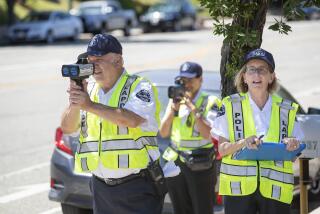‘55-Limit Is Unenforceable’
- Share via
Henley’s article was excellent. She was, however, in my opinion, far too easy on the bureaucrats who have saddled us with this law--probably the dumbest since Prohibition.
For one thing, let’s suppose that it is true that increasing the speed limit from 55 to 65 would cause more fatalities and/or accidents. What kind of person would deduce from this that the speed limit should be kept at the lower figure? Presumably the same individual who, upon realizing that the brakes in his car were fading, would arrange to have the horn made louder. If we can’t drive in excess of 55 m.p.h. on our interstate freeways using the best automobiles that modern technolog ycan afford, then I suggest we should learn to drive.
Proving any correlation between the speed limit and driving fatalities is, in any case, tenuous. Traffic fatalities decreased in ’74 after the 55-limit was introduced and again in the early ‘80s when compliance decreased and the average speed limit rose. Fatalities decreased in states that reduced their drinking age and in states that raised their drinking age.
Henley correctly believes that if the speed limit were increased to 65, people would not tend to drive at 75 m.p.h. She bases this conclusion on a gut reaction. However, in addition, speed limits should reflect the behavior of the majority who will drive at a reasonable and proper speed and are quite capable of recognizing conditions that warrant lower speeds than the maximum. Studies have also shown that accidents are five times more likely to occur where motorists are traveling at all different speeds. This situation, of course, is most likely to occur under the 55-limit.
CLYDE G. LONERGAN
Los Angeles
More to Read
Sign up for Essential California
The most important California stories and recommendations in your inbox every morning.
You may occasionally receive promotional content from the Los Angeles Times.












